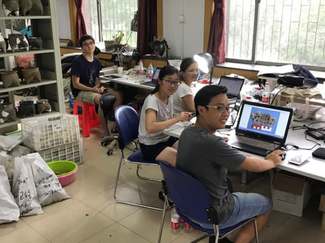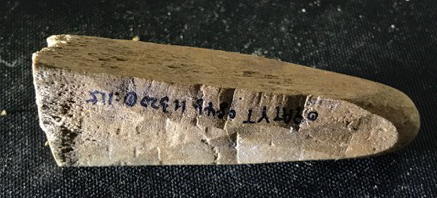Bone Working and the Chinese Bronze Age Economy
This article first appeared in ISAW Newsletter 20 (Winter 2018).
Rod Campbell
Associate Professor of East Asian Archaeology and History
 Daxingzhuang Bone-Working Team
The economies of the first Chinese dynasties are as little studied as they are crucial to an understanding of early Chinese civilization. Despite nearly a century of work our sources remain elite-biased and scholarly focus remains resolutely on rich tombs and royal palaces. Even what little study has been done on the economy of China’s first historical dynasty, the Shang, has been centered on elite crafts and putative state monopolies. A lack of early economic records has led Chinese economic historians to assume the absence of economic development before the textual evidence of the Eastern Zhou period, some 500 years after the Shang. In the Chinese Bronze Age Economics Project, my collaborators and I have been gradually changing that picture.
Daxingzhuang Bone-Working Team
The economies of the first Chinese dynasties are as little studied as they are crucial to an understanding of early Chinese civilization. Despite nearly a century of work our sources remain elite-biased and scholarly focus remains resolutely on rich tombs and royal palaces. Even what little study has been done on the economy of China’s first historical dynasty, the Shang, has been centered on elite crafts and putative state monopolies. A lack of early economic records has led Chinese economic historians to assume the absence of economic development before the textual evidence of the Eastern Zhou period, some 500 years after the Shang. In the Chinese Bronze Age Economics Project, my collaborators and I have been gradually changing that picture.
 Chisel marks on worked antler, Wangyukou, Anyang
Our work on a gigantic bone working site at Tiesanlu, Anyang demonstrated that millions of quotidian bone artifacts were mass-produced for wide distribution. Subsequent work at the only well-excavated Shang village in existence, Guandimiao, showed that the mass-produced products of the Anyang workshop reached even this tiny, poor and remote village (200 km from Anyang, population < 100). Both the existence of bone artifact factories (producing mostly hairpins) and the presence of their products in small villages demonstrate the need to think beyond elite exchange networks and reconsider the complexity of the early Chinese economy. Continuing this work over the summer of 2017 at two new sites, we discovered evidence for a kind of bone working intermediary to unskilled domestic production and specialized mass-production.
Chisel marks on worked antler, Wangyukou, Anyang
Our work on a gigantic bone working site at Tiesanlu, Anyang demonstrated that millions of quotidian bone artifacts were mass-produced for wide distribution. Subsequent work at the only well-excavated Shang village in existence, Guandimiao, showed that the mass-produced products of the Anyang workshop reached even this tiny, poor and remote village (200 km from Anyang, population < 100). Both the existence of bone artifact factories (producing mostly hairpins) and the presence of their products in small villages demonstrate the need to think beyond elite exchange networks and reconsider the complexity of the early Chinese economy. Continuing this work over the summer of 2017 at two new sites, we discovered evidence for a kind of bone working intermediary to unskilled domestic production and specialized mass-production.
This type of bone working, evidenced at a recently excavated locus at Anyang, called Wangyukou, and at the regional center of Daxingzhuang in Shandong province (300 km from Anyang), is characterized by the skilled, or semiskilled production of a large variety of everyday bone tools. Combined with the palace workshops, this suggests the existence of at least four different modes of bone artifact production, each associated with a different distribution network and some kind of generalized means of exchange: fine palace production; large-scale specialized mass-produced artifacts; small, unspecialized workshop production; and domestic production. If the bone economy is this complex, what does that say about the ceramic, bronze, textile, lacquer, wood, stone economies? Whatever the answers to these questions turn out to be, the truth is sure to be richer and more complex than has been considered, and with a thorough economic re-appraisal, the rest of the narrative of early Chinese civilization will have to be re-written as well.